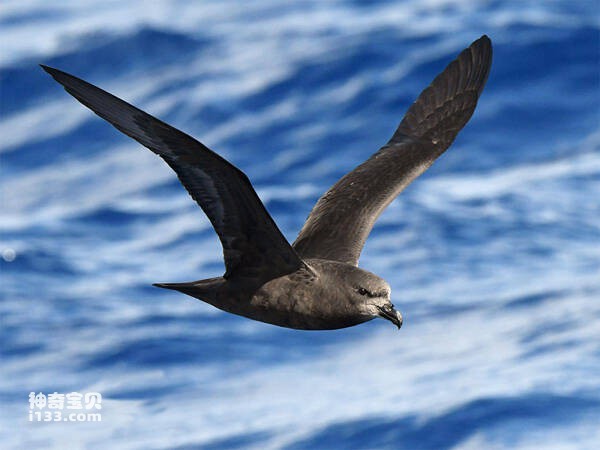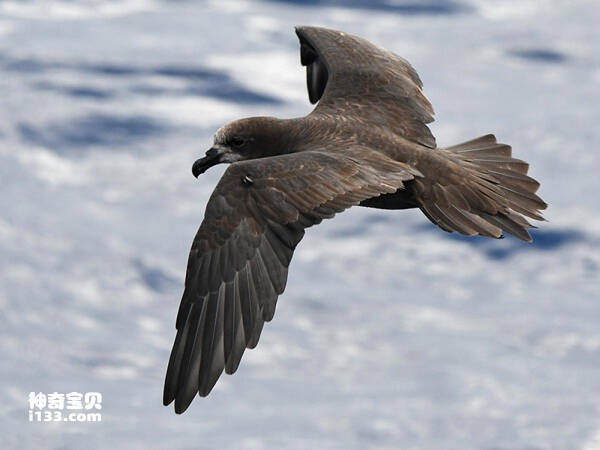Pterodroma gouldi
IUCN
LCBasic Information
Scientific classification
- name:Pterodroma gouldi
- Scientific Name:Pterodroma gouldi,Grey-faced Petrel
- Outline:Waterfowl
- Family:
Vital signs
- length:38-40CM
- Weight:385-680g
- lifetime:No textual research information is available
Feature
It is a large seabird with dark plumage, long pointed wings, and a wedge-shaped tail
Distribution and Habitat
It is found in Australia, New Zealand and Norfolk Island. Breeds in many colonies around the northern part of New Zealand's North Island. Outside the breeding season, it is scattered in the subtropical southwest Pacific, mainly between 25-50 degrees south latitude, but some birds also stray into the Antarctic region.
This Marine species is highly pelagic and is widely but sparsely distributed at sea. They are one of the few burrowing seabirds that can still survive on the New Zealand mainland. Small communities are scattered around the coast of the upper North Island, mainly on headlands and peninsulas facing the sea. Breeding usually takes place below 400 meters above sea level. Nests are found mainly in caves under tall forests, but also under grass or brush, especially near cliffs above the sea. Sandy or loose soil with few rocks and roots is preferred.
Appearance
The grey-faced shearwater is 38-40 cm long, weighs 385-680 g and has a wingspan of 97-100 cm. It is a large seabird with dark plumage, long pointed wings, and a wedge-shaped tail. At sea, they are fast and graceful, soaring high on their long, narrow wings. The species has long, narrow wings and a long, pointed tail. The entire body is evenly dark black-brown, but occasionally has lighter brown frayed feathers. The base and throat of the beak are grey or pale yellow. It has a stout, short, powerful, black, sharp, deeply hooked beak that is 33-40 mm long. Eyes and legs are black.
Details
The Grey-faced Petrel (Pterodroma gouldi) has no subspecies. Petrel del Hoyo and Collar 2014) and Pterodroma macroptera (Pterodroma macroptera) were classified as two subspecies before 1993. Pterodroma macroptera" It was divided into two separate species in 2014.

During the breeding season, the grey-faced shearwater feeds mainly in the Tasman Sea or eastern New Zealand, near the edge of the continental shelf, or deeper, and can range for thousands of kilometres. During summer molting, they are widely distributed across the Tasman Sea to the Australian coast, reaching parts of the Coral Sea.
The grey-faced Shearwater is nocturnal in its breeding grounds. Unlike the species of this genus on the southern islands, they are very active in the community at night, calling and searching for burrows, moving and sleeping on shore. On dark nights with wet weather, the activity on shore is more pronounced, but will return on windy nights under bright moonlight. Spectacular aerial courtship chases over the colony are a feature of the species, and breeding grounds can be very noisy during April-May and August. At sea, they quickly fly to the edge of the continental shelf before starting to feed. Can travel great distances in search of food, and the birds have been recorded flying as far as the east coast of Australia while their partners incubate their eggs. After breeding, the grey-faced shearwater mainly disperses to warmer waters around the North Tasman Sea or southern and eastern Australia.

The grey-faced shearwater has a wide diet, most often feeding on squid, but also eating crustaceans and fish. It catches prey at night, but often stops at sea during the day and may hunt. Smaller squid are caught alive at the surface, but larger squid may have been eaten when the dead animal floated to the surface. Studies of the species' diving abilities have shown that they feed primarily at 5 meters below the surface, but can occasionally dive deeper, perhaps to 20 meters. Predation occurs at night, likely due to the prevalence of bioluminescence in the species it preys on, suggesting that this is the bird's method of locating prey. It occasionally appears after cetaceans and mixes with other shearwater birds. The main flight call is a high-pitched whistle whi-her, wik-wik, or a low groan oor-wik. These same calls are often made on the ground or in caves.
The grey-faced Shearwater breeds in northern New Zealand, islands and some continental headlands. These birds start breeding in the middle of winter, but many chicks don't fledge until the middle of summer. Some Maori tribes still exercise their right to capture the island, harvesting grey-faced shearwater chicks between mid-November and mid-December each year. As many of the breeding islands' predators are removed, the grey-faced shearwater will thrive again.

The breeding season is roughly from early March to January of the following year, nesting in loose colonies on ridges, slopes or flat ground on islands in the ocean, using burrows that may be about 1.5 meters long. One white egg, 68x48 mm in size, is laid between mid-June and late July. The neatly arranged nests are located at the end of long burrows dug into the soil or vegetation. The eggs hatch in August or September for about 55 days, and the chicks feather at about 118 days old between November and January of the following winter. The species reproduces once a year; Very few pairs skip the breeding season. Both sexes share the incubation and care of the chicks. The chicks fledge in late December. Immature young birds begin to return to the colony at age 3 and can breed as early as age 4, but most will delay breeding until 8-10 years of age.
Invasive mammalian predators are a major threat to the grey-faced shearwater. Cats, Polynesian mice, brown mice, house mice, stoats, and pigs are all known to cause a decline in breeding success by raiding nests, which can lead to population declines, and cats also capture adult birds. Eradication efforts have been undertaken to reduce cat and Polynesian rat populations. Removal of each species from breeding islands resulted in an increase in the population of grey-faced shearwaters (Greene et al., 2015). Cats remained on a breeding island and distributed across the continent outside the fenced area, while Polynesian rats remained in certain areas of their range. Brown and house mice remained on nine and 14 breeding islands, respectively. The species is still legally fished on some offshore islands in the Bay of Plenty and Hauraki Gulf; However, attempts have been made to ensure that the current harvest is sustainable (Greene et al., 2015).
Listed on the IUCN Red List of Threatened Species (IUCN)2018 ver3.1 - Not Threatened (LC).
Protect wild animals and eliminate wild meat.
Maintaining ecological balance is everyone's responsibility!








